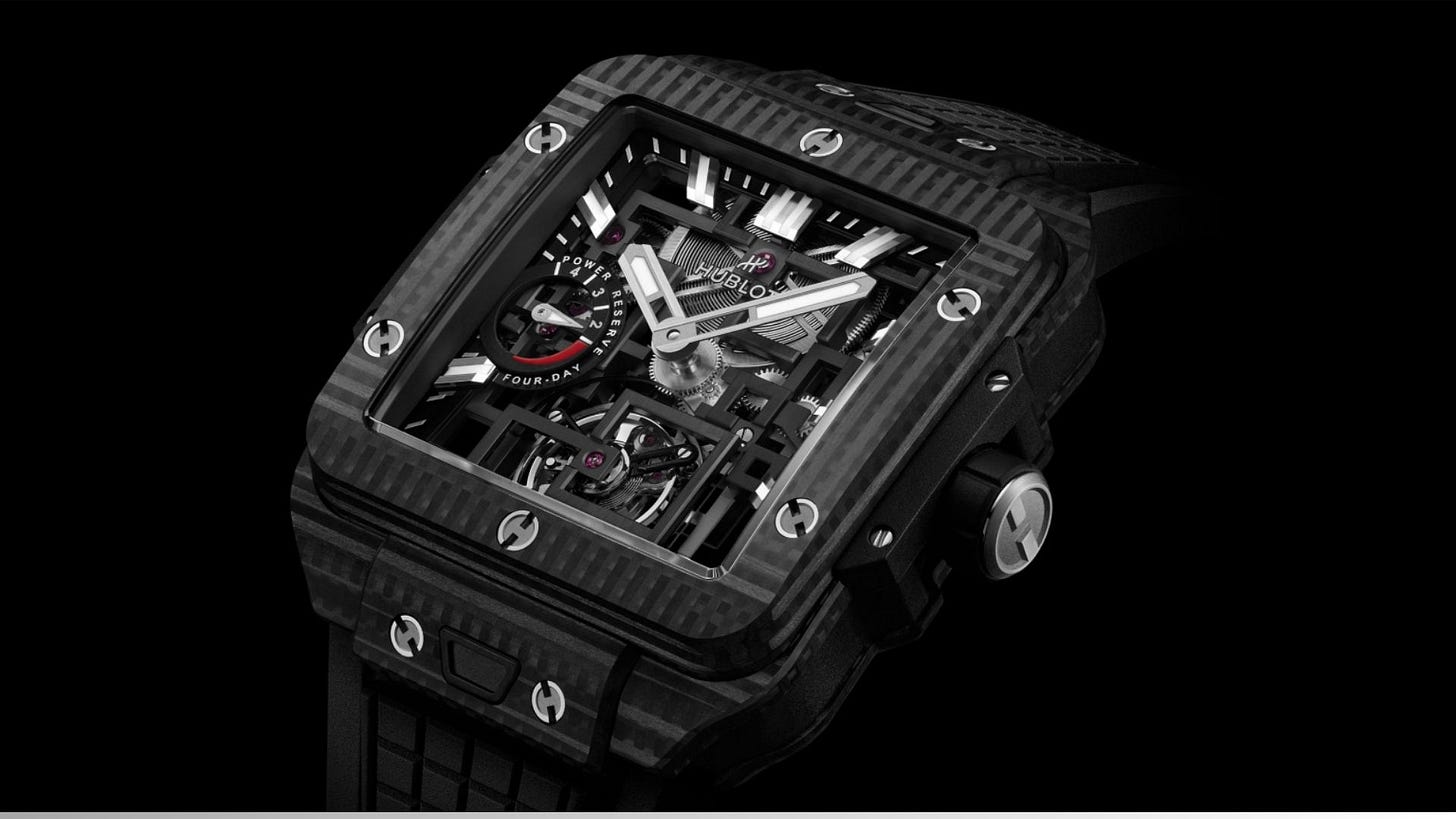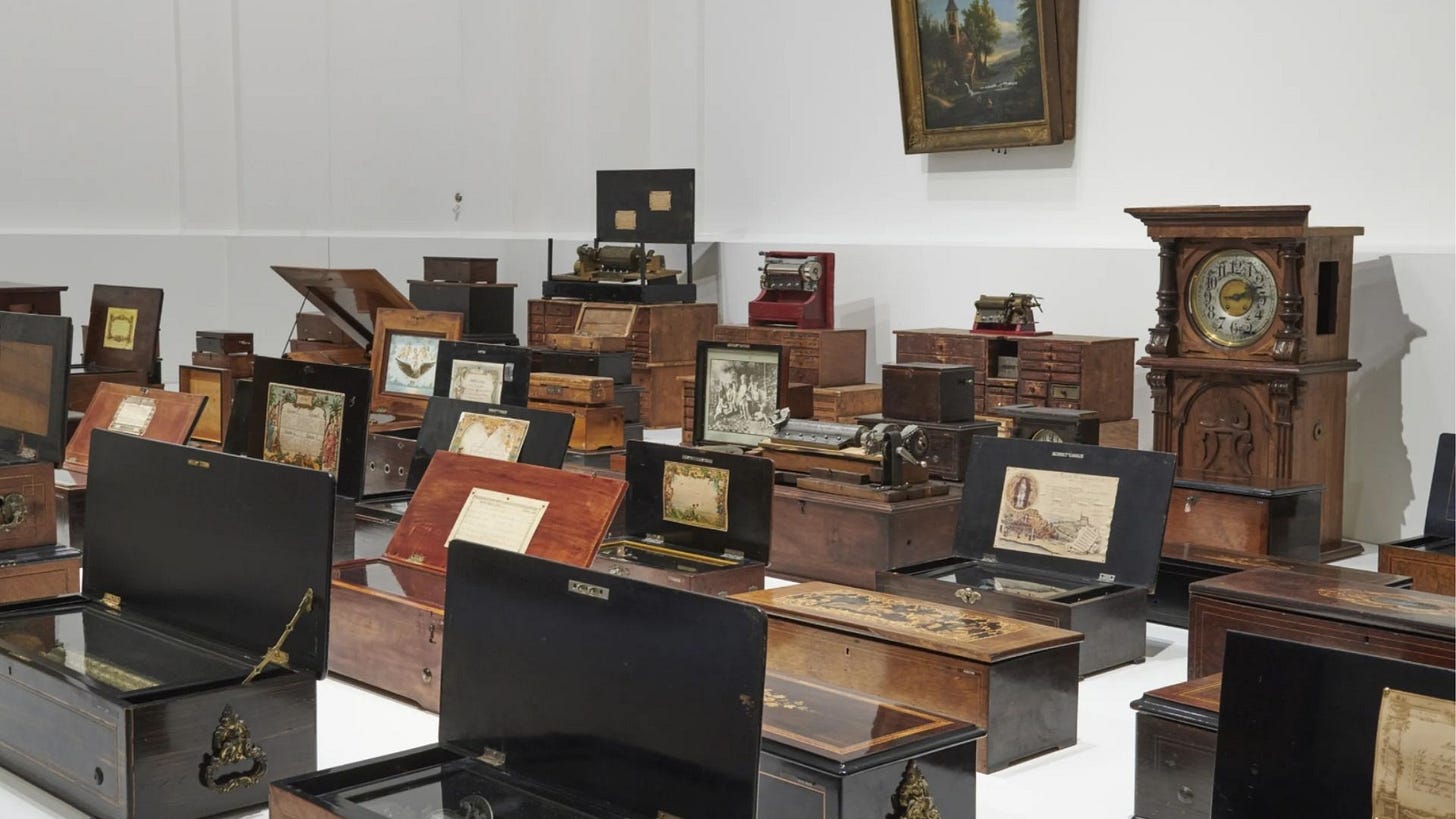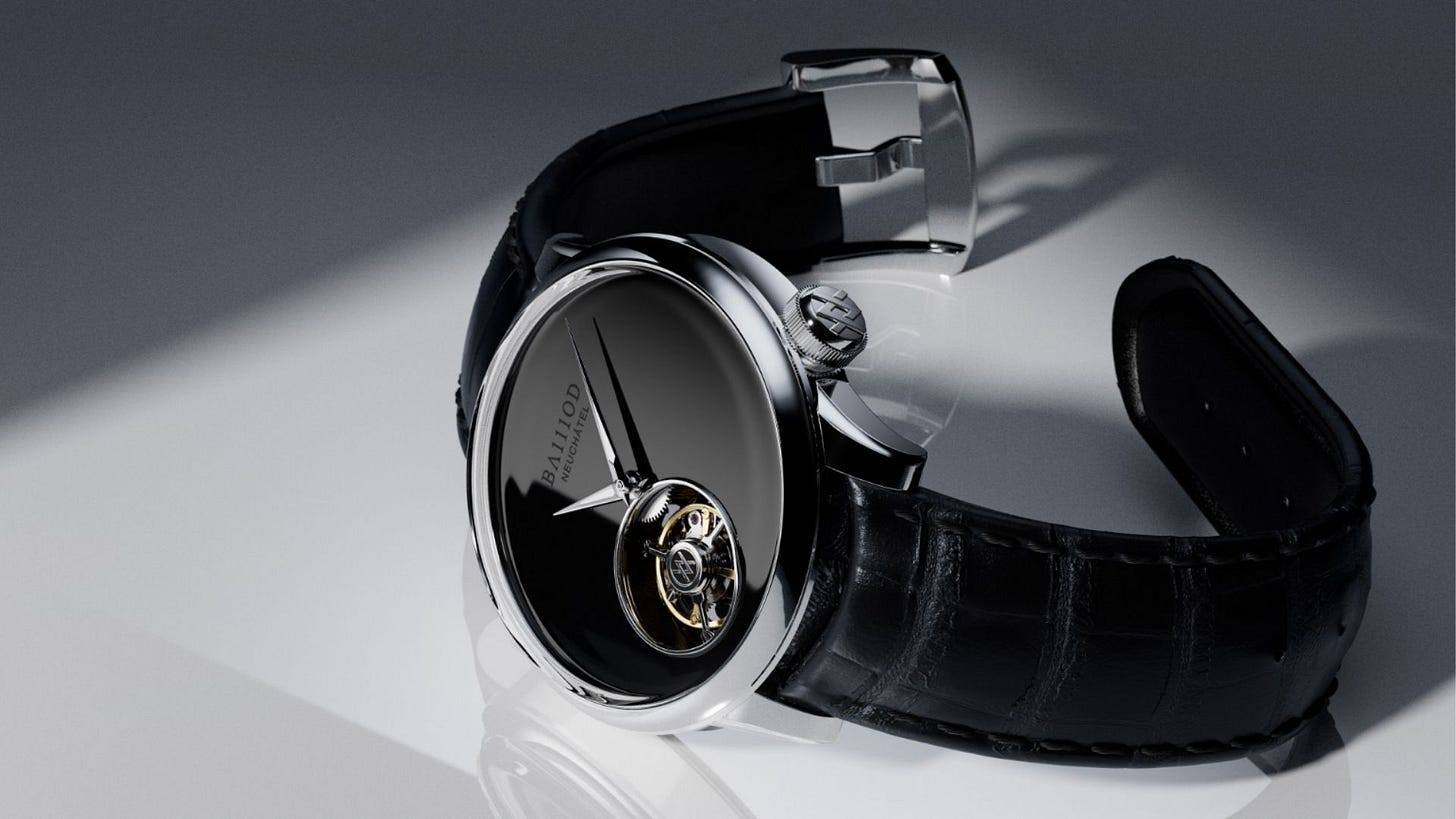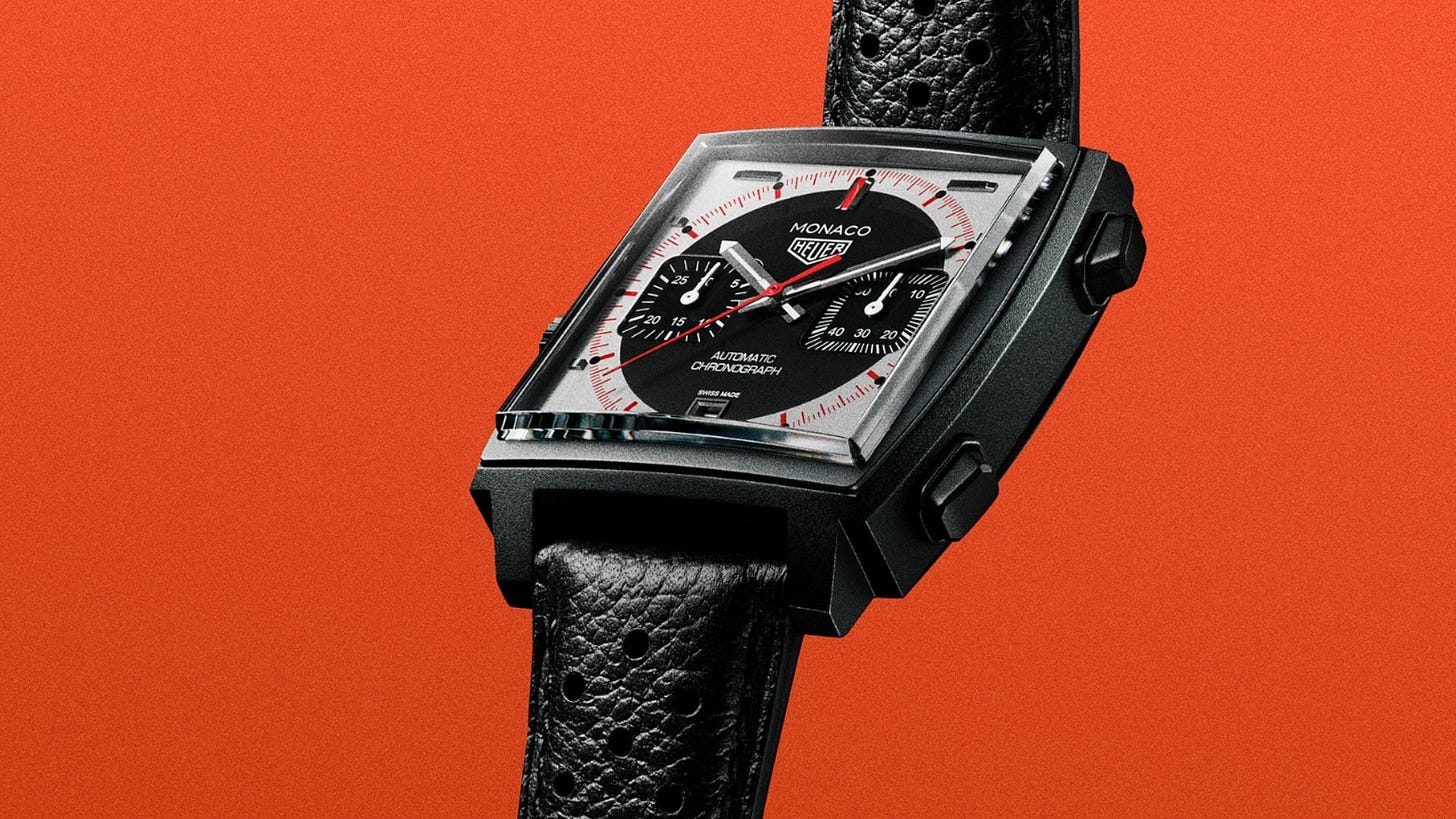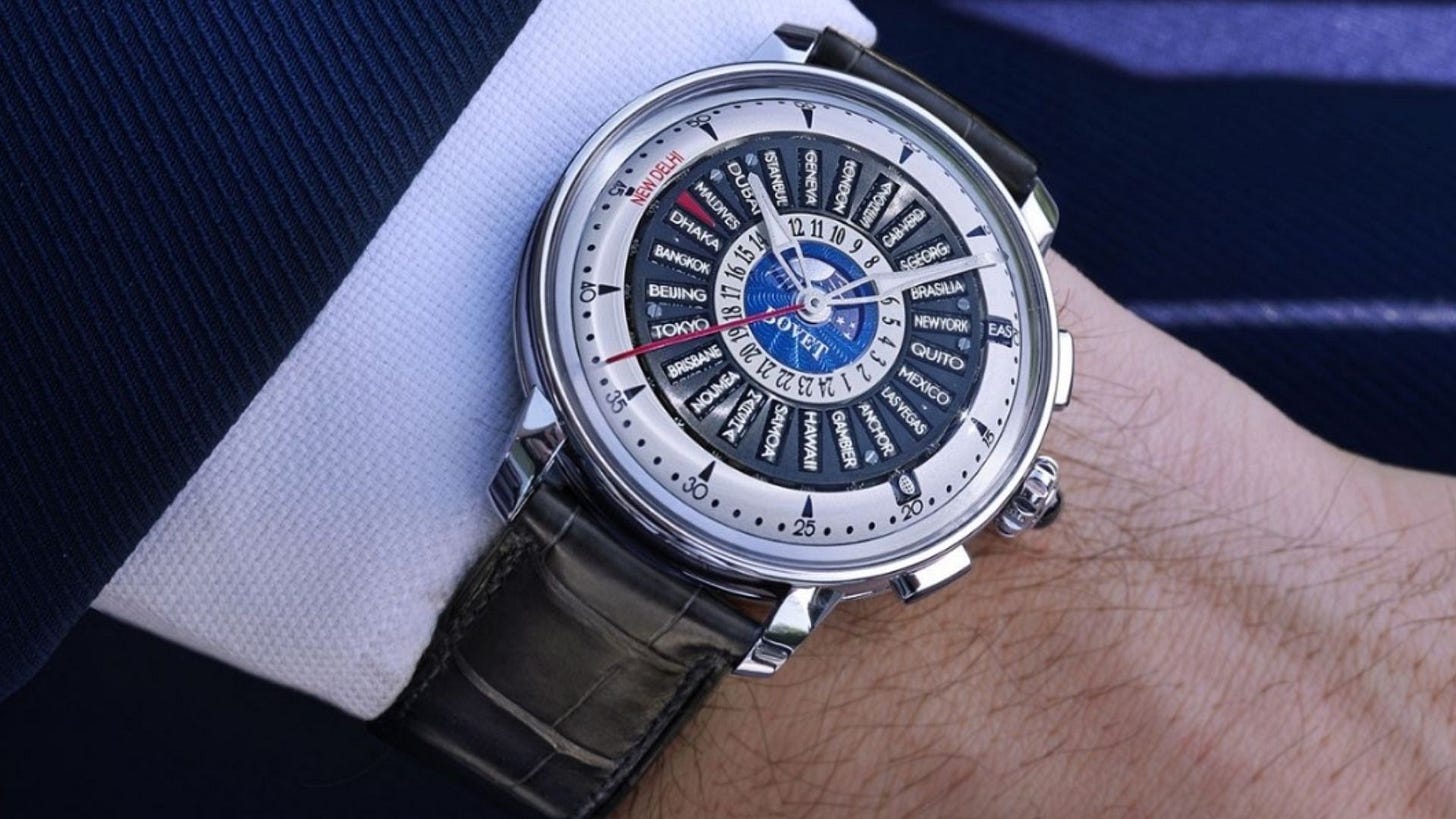Hublot Goes Square, TAG Heuer Races On, and BA111OD Highlights Onyx Elegance
This week on WorldTempus: Hublot reshapes design with the Square Bang, TAG Heuer’s Monaco Chronograph Stopwatch celebrates motorsport, and BA111OD strips back to pure onyx tourbillon elegance.
THIS WEEK’S NEWS
A Bold New Dimension in Watchmaking
Hublot’s Square Bang Tourbillon 4-Day Power Reserve is redefining the traditional boundaries of watch design and mechanical excellence. With this model, the brand has expanded its iconic Big Bang family beyond round and tonneau-shaped cases, unveiling a square format that is both radical and refined. The 42mm square case, crafted from 3D carbon composite, is meticulously structured with horizontal and vertical weaves that extend seamlessly into a rubber strap adorned with square motifs, creating a cohesive design narrative.
At the heart of this timepiece beats the MHUB6023 manual movement, developed exclusively by Hublot’s in-house Manufacture. This calibre consists of 174 components and features bridges that are strictly square or rectangular. Each component is precisely finished with alternating matte and satin surfaces, emphasizing the skeletonized design’s depth and complexity. The architecture is deliberate, with key elements positioned on each side of the square: winding mechanism on the right, power reserve on the left, large barrel at the top, and the tourbillon at the bottom.
Julien Tornare, CEO of Hublot, describes the vision: "Until now, advances in square watches have been rather timid, usually confined to the case alone. With the Square Bang Tourbillon 4-Day Power Reserve, we wanted to take the exercise to its logical conclusion, by designing a movement whose architecture is also fully right-angled."
This tourbillon model integrates a silicon escapement, providing resilience against magnetic fields and temperature changes. The power reserve, indicated at nine o’clock, extends to an impressive four days, ensuring reliable performance and elegance. With its intricate skeletonized movement and innovative square geometry, Hublot’s new creation masterfully blends design audacity and technical prowess, affirming the Square Bang’s unique place in Haute Horlogerie.
A Lifelong Symphony of Mechanical Music
In the heart of Geneva’s Musée d’Art et d’Histoire, a remarkable collection of mechanical music boxes stands as a testament to the life and passion of Jacques-Antoine Horngacher. This captivating exhibition brings together 135 music boxes meticulously gathered by Horngacher, along with chimes from St. Peter’s Cathedral, a dozen of the museum’s own treasures, and even a charming cuckoo clock. The display celebrates the enduring allure of mechanical music, with melodies resonating throughout the museum in tribute to their collector’s legacy.
Horngacher’s fascination began when, as a boy in 1939, he discovered a discarded music box in Geneva’s Plainpalais flea market. His innate curiosity about mechanisms sparked a lifelong interest. At just 10 years old, he crafted a carillon from bicycle bells. By 12, he received his first real music box—a gift from an aunt that coincided with his mother’s death, an event that deeply influenced him. Despite his exceptional talent in mathematics and watchmaking, his presentation of a music box at watchmaking school was dismissed as "not watchmaking." However, in 2020 watchmaking and art mechanics were recognized as part of UNESCO’s Intangible Cultural Heritage of Humanity.
An internationally respected expert, Horngacher developed a detailed classification of music boxes, tracing their evolution from early blade systems to perforated paper mechanisms. His approach combined scientific rigor with a personal touch, naming each box after individuals in his life. Since his bequest in 2013, the museum has meticulously restored each piece, and select boxes now play during demonstrations and on the museum’s website.
Geneva’s Musée d’Art et d’Histoire was a fitting choice to house this collection. As Estelle Fallet, the museum’s curator, explains, the city holds a special place in the history of music boxes. Antoine Favre’s 1795 discovery of vibrating blade properties marked the birth of the music box, sparking a thriving industry that once produced thousands of these mechanical marvels. Horngacher’s legacy, now on display, offers visitors a poignant journey into a world where mechanical ingenuity and emotional resonance converge.
NEW WATCHES
Sculpted Elegance in Onyx
With its latest creation, the Chapter 4 Onyx Flying Tourbillon, BA111OD strips haute horlogerie down to its most essential form, blending contemporary minimalism with technical mastery. Following the success of its previous tourbillon featuring moon phase and small seconds complications, the Neuchâtel-based brand now offers a radically pared-down interpretation that focuses solely on purity of design and mechanical virtuosity.
The Chapter 4 Onyx Flying Tourbillon represents the evolution of the soon-to-be-retired Chapter 4.7 Onyx Tourbillon. By removing visual distractions and superfluous elements, the eye is drawn directly to the timepiece’s focal point: the flying tourbillon. This sophisticated mechanism, devoid of its upper bridge, seems to float within the openworked cage, creating an entrancing dance of motion. Crafted with precision, the tourbillon not only showcases Swiss watchmaking savoir-faire but also exemplifies BA111OD’s pursuit of visual and technical lightness.
The dial, cut from polished black onyx, adds a layer of depth and intrigue. This natural stone, known for its density and intensity, absorbs light, evoking an infinite night sky. The absence of logos and the discreet tone-on-tone signature emphasize the watch’s understated elegance. The 904L stainless steel case, polished and featuring a concave profile with a recessed bezel, balances contemporary design with timeless refinement. Measuring 41mm, the case maintains a bold yet wearable presence, topped with an anti-reflective, box-shaped sapphire crystal that highlights the tourbillon’s graceful motion.
A collaboration with master watchmaker Olivier Mory brings this vision to life, reinforcing BA111OD’s commitment to making exceptional craftsmanship accessible. As Thomas Baillod, founder of the brand, notes, “We wanted a watch that speaks to the senses before it speaks to reason. Something rare, yet readable. Silent, yet powerful.”
The Chapter 4 Onyx Flying Tourbillon embodies BA111OD’s Neuchâtel heritage, blending tradition and innovation in a composition where shadow meets light, simplicity meets complexity, and every detail celebrates a sculptural expression of time.
A New Era of Precision with the TAG Heuer Monaco Chronograph Stopwatch
TAG Heuer’s latest release, the limited-edition Monaco Chronograph Stopwatch, stands as a bold tribute to its racing heritage and the precise timekeeping demanded by motorsport. Marking the brand’s historic role as the first title partner in the Formula 1 Grand Prix de Monaco, this timepiece is a seamless fusion of iconic design and contemporary performance.
Drawing inspiration from the Heuer stopwatches that defined racing in the 1960s and 70s, the Monaco Chronograph Stopwatch captures the clarity and functionality that once guided timekeepers in the heat of competition. The distinctive black, white, and red color palette directly references these vintage instruments, while the opaline silver background of the dial ensures stark contrast for optimal legibility. Vivid red markings on the minute track and a striking red lacquered second hand reinforce its motorsport DNA. Blackened hour markers and hands, paired with high-contrast white subdial elements, create a dial that is both bold and precise.
At its heart, the watch is powered by the Calibre 11, a movement that pays homage to the original Monaco’s groundbreaking design. The lightweight black DLC-coated titanium case, with its signature left-side crown, preserves the square silhouette that set the 1969 Monaco apart from its contemporaries. This nod to the past is complemented by modern materials and a black perforated calfskin strap, reminiscent of racing gloves, that secures the watch comfortably on the wrist.
Produced in a limited run of 970 pieces—a deliberate reference to the brand’s racing legacy from the 1970s—this timepiece is more than just a watch. It is a symbol of the enduring relationship between TAG Heuer and the world of motorsport. Delivered in special packaging echoing its bold color scheme and featuring a custom travel pouch, the Monaco Chronograph Stopwatch is designed for those who appreciate both the art of watchmaking and the thrill of racing.
WATCH KNOWLEDGE
The Untold Story of the Maltese Cross
For many, the Maltese Cross instantly evokes Vacheron Constantin, a symbol as iconic as Rolex’s crown or Omega’s Greek letter. However, this emblem is not merely a graphic signature—it represents an actual horological component. Unlike other brand logos, the Maltese Cross draws directly from the mechanics of watchmaking, though intriguingly, it is no longer used in modern production by the Swiss Manufacture.
Historically, the Maltese Cross was a key part of a watch’s stopwork mechanism. In the 19th and 20th centuries, especially in pocket watches, this device was fitted at the mainspring barrel to limit winding. When a user wound the watch, the Maltese Cross determined the number of turns—usually four—by employing teeth on its “arms.” The fourth tooth was deliberately designed to block the mechanism, preventing overwinding and the potential damage caused by excessive tension in the mainspring.
Vacheron Constantin adopted the Maltese Cross as its logo in 1880, recognizing its deep horological roots. Yet today, this clever mechanism has largely faded from watchmaking. Technological advancements have rendered the Maltese Cross obsolete for most brands, including Vacheron Constantin itself. The last remnants of its functionality appear in some independent makers and niche complications. Urwerk uses it for satellite rotations, while Ludovic Ballouard’s Upside Down watch features twelve Maltese Crosses, each governing the instantaneous jumping of hour numerals.
While the emblem remains a proud symbol of Vacheron Constantin’s legacy, its practical role has shifted into the background. However, the enduring appeal of the Maltese Cross—both as a logo and a functional component—underscores the deep connection between artistry, mechanics, and tradition in haute horlogerie. Its story is a fascinating reminder that even the most recognized symbols can harbor layers of meaning and history waiting to be rediscovered.
Bovet’s Récital 30: A Fusion of Tradition and Modernity
Pascal Raffy, CEO of Bovet, shares the intimate story behind the Récital 30, a contemporary world timer that reflects the brand’s rich heritage while embracing a modern spirit. Inspired by a conversation with his daughter Alexandra, and son, the watch was envisioned as a “middle complication” that marries the functional elegance of world timekeeping with a neo-vintage aesthetic. Alexandra’s idea of a universal time display for the entire year, complemented by sky-blue and yellow accents, sparked a concept that blends clarity, color, and innovation. “Now I understand the future,” Raffy reflected.
The Récital 30 builds on the mechanical ingenuity of the Récital 28 Prowess 1, which won the Mechanical Exception Prize at the Grand Prix d’Horlogerie de Genève 2024. It employs a unique system of rollers and rotating discs to precisely display 25 global time zones, including adjustments for daylight savings shifts throughout the year. This inventive solution, realized in only two timepieces to date, elegantly resolves the complexities of universal timekeeping.
At the heart of the Récital 30 is a fully in-house crafted automatic movement with over 62 hours of power reserve. Its neo-vintage design bridges past and present, with an off-white dial, navy-blue lacquered guilloché at the center, and a fleurisanne decorated rotor visible from the back. Crafted from titanium or gold, the 42mm case embodies both traditional elegance and contemporary flair. While not strictly limited editions, production is capped—only 30 red gold pieces for 2025, all pre-ordered.
Bovet’s commitment to bespoke craftsmanship shines through in the personal touch of the Récital 30. Whether displaying New Delhi’s 30-minute time zone, Adelaide’s unique placement, or Nepal’s rare 45-minute offset, the watch reflects the brand’s enduring legacy of customization. Raffy believes each bespoke project should be a collaborative, artistic exchange, rooted in genuine human connection.
He emphasizes that while the Récital 30 may be a “middle complication,” its understated brilliance and exceptional hand-finishing remain true to Bovet’s haute horlogerie standards. It exemplifies the Maison’s dedication to blending artistry, humanity, and enduring values into every timepiece.
MUST-SEE THIS WEEK
Louis Vuitton Celebrates Formula 1® Grandeur in Monaco
Louis Vuitton once again redefines elegance and innovation in the world of motorsport with the presentation of its bespoke Trophy Trunk for the FORMULA 1® TAG HEUER GRAND PRIX DE MONACO 2025. As the House marks its fifth consecutive year partnering with this prestigious event, it also debuts a bold new creative signature for the on-track signage in Monte-Carlo, merging Louis Vuitton’s distinctive style with the high-octane atmosphere of Formula 1®.
This year’s Monaco Grand Prix—one of the sport’s most iconic races—coincides with the 75th anniversary of Formula 1®, adding even more significance to the spectacle unfolding from May 23rd to May 25th. Louis Vuitton’s dynamic new on-track graphic signature, capturing movement and energy, integrates seamlessly into Monte-Carlo’s renowned circuit, celebrating the elegance and cultural richness of Monaco’s unique setting.
Reflecting both the heritage of the House and the modern spirit of racing, the Louis Vuitton Trophy Trunk pays homage to Monaco’s vibrancy. Adorned with the House’s emblematic Monogram canvas and a striking red and white V for “Victory” and “Vuitton,” the trunk’s design honors the Monaco flag. Each bespoke piece is meticulously handcrafted at Louis Vuitton’s historic atelier in Asnières, France—the same workshop where Georges Vuitton, son of the founder, pioneered the first automotive trunks in 1897. His innovative spirit, embodied in the creation of “Vuittonite” canvas to withstand the rigors of travel, continues to shape the brand’s legacy in luxury craftsmanship.
Louis Vuitton’s involvement with Formula 1® is part of the broader LVMH partnership established in October 2024, reinforcing the House’s role as a symbol of excellence at the intersection of fashion, sport, and culture. The Trophy Trunk not only embodies the precision and inventiveness of both Louis Vuitton and Formula 1®, but also highlights a shared dedication to celebrating moments of victory.
This year’s collaboration encapsulates a timeless message: “Victory Travels in Vuitton,” connecting generations of drivers, fans, and the enduring allure of Monaco’s Grand Prix.





